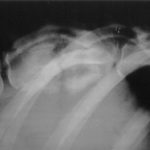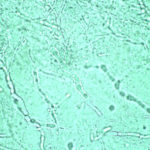Date: 7 May 2013
Copyright: n/a
Notes:
Colonies on CYA 40-60 mm diam, plane or lightly wrinkled, low, dense and velutinous or with a sparse, floccose overgrowth; mycelium inconspicuous, white; conidial heads borne in a continuous, densely packed layer, Greyish Turquoise to Dark Turquoise (24-25E-F5); clear exudate sometimes produced in small amounts; reverse pale or greenish. Colonies on MEA 40-60 mm diam, similar to those on CYA but less dense and with conidia in duller colours (24-25E-F3); reverse uncoloured or greyish. Colonies on G25N less than 10 mm diam, sometimes only germination, of white mycelium. No growth at 5°C. At 37°C, colonies covering the available area, i.e. a whole Petri dish in 2 days from a single point inoculum, of similar appearance to those on CYA at 25°C, but with conidial columns longer and conidia darker, greenish grey to pure grey.
Conidiophores borne from surface hyphae, stipes 200-400 µm long, sometimes sinuous, with colourless, thin, smooth walls, enlarging gradually into pyriform vesicles; vesicles 20-30 µm diam, fertile over half or more of the enlarged area, bearing phialides only, the lateral ones characteristically bent so that the tips are approximately parallel to the stipe axis; phialides crowded, 6-8 µm long; conidia spherical to subspheroidal, 2.5-3.0 µm diam, with finely roughened or spinose walls, forming radiate heads at first, then well defined columns of conidia.
Distinctive features
This distinctive species can be recognised in the unopened Petri dish by its broad, velutinous, bluish colonies bearing characteristic, well defined columns of conidia. Growth at 37°C is exceptionally rapid. Conidial heads are also diagnostic: pyriform vesicles bear crowded phialides which bend to be roughly parallel to the stipe axis. Care should be exercised in handling cultures of this species.
Images library
-
Title
Legend
-
Saggital section of kidney from a German shepherd dog with disseminated aspergillosis. There are granulomata within the medulla, and fungal material within the renal pelvis. Renal involvement in canine dissemianted aspergillosis is common, and the demonstration of fungal hyphae within urine sediment is a useful screening test.

-
Saggital section of the vertebral column of a dog with discospondylitis as part of disseminated aspergillosis due to A. terreus

-
Discospondylitis – Radiograph of thoracolumbar vertebrae of a 2 year old, female German shepherd dog with disseminated aspergillosis demonstrating discospondylitis of T13-L1.

-
Wasting and paraplegia – A 2 year old, male German shepherd dog with disseminated aspergillosis due to A. terreus. The marked loss of condition of this dog occurred within two months of initial diagnosis.

-
A 2 year old, female German shephered dog with disseminated aspergillosis due to A. terreus. There is muscle wasting and paraplegia due to discospondylitis involving T13-L1.

-
Draining sinus tract on left forelimb of a 4 year old, female Dalmatian with disseminated aspergillosis. There was an underlying osteomyelitis of distal humerus from which A. terreus was cultured.

-
Aspergillus sinusitis in a dog. Long nosed dogs are at relatively high risk of Aspergillus sinusitis as shown in this example.

-
English Pointer with nasal aspergillosis. Gram stained cytological smear of material obtained from the frontal sinus of a 7 year old English Pointer with nasal aspergillosis. This infection was caused by Aspergillus fumigatus. Magnification x 200.

-
Domestic crossbred cat with disseminated aspergillosis. KOH preparation of material obtained from thoracotomy of a 3 year old domestic crossbred cat with invasive Aspergillus fumigatus infection. The cat had marked enlargement of the hilar lymph nodes that resulted in a partial tracheal obstruction. This preparation was made from portions of the hilar lymph node resected at thoracotomy. Magnification x 132.

-
Rottweiler treated with indwelling plastic tubes. Photograph of a Rottweiler crossbred dog treated with indwelling plastic tubes placed surgically into the nasal cavity and frontal sinuses.


![Asp[1]fumighead2copyr Asp[1]fumighead2copyr](https://www.aspergillus.org.uk/wp-content/uploads/2013/11/Asp1fumighead2copyr.jpg)